NASA recently took some of its most promising new concepts for living and working on the moon and tried them out in a moon-like location near Lake Moses, Washington. Scout robots, rovers, cargo carriers, cranes and spacesuits endured sand storms and temperature swings to help test out the prototypes and prepare for future lunar expeditions. Although conditions on the moon will be much harsher, one investigator said, “It’s as close as we can get in a terrestrial environment to the lunar environment.” Above is the Mobile Lunar Transporter, which includes unique features that allow each of its six wheels to move independently, giving the vehicle the ability to drive in any direction. The human drivers stood in turrets on the “trucks.”
JPL tested two ATHLETE cargo-moving rovers they are developing. These rather odd-looking transport vehicles have legs capable of rolling or walking over extremely rough or steep terrain. They can carry, manipulate, deposit and transport payloads to desired sites. Maybe they’ll become the lunar version of a Winnebago, and future lunar astronauts can also take them out on weekend camping trips.
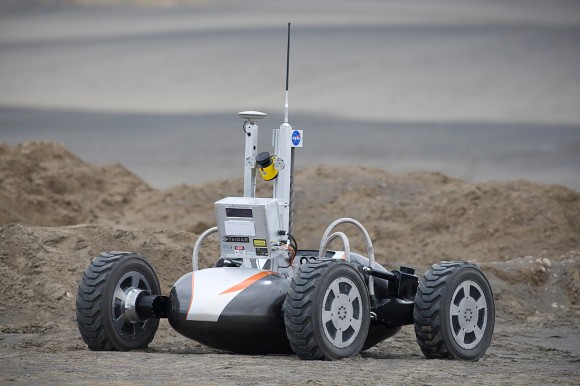
This Autonomous Drilling Rover could be used to search for valuable resources under the lunar surface in the moon’s polar regions. Its made to operate in extreme cold and dark conditions.
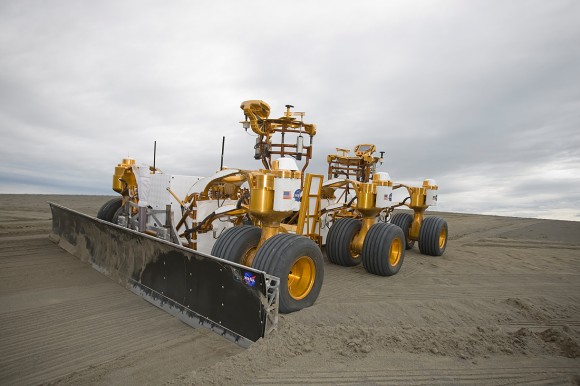
This lunar bulldozer, called LANCE (Lunar Attachment Node for Construction Excavation), is designed to be used with the lunar truck. The bulldozer can be used to help prepare a site for building an outpost on the moon.
These K10 scout robots can perform highly repetitive and long-duration tasks. During the tests, the rovers surveyed simulated lunar landing sites and built topographic and panoramic 3-D terrain models. One rover used a ground-penetrating radar to assess subsurface structures. The other used a 3-D scanning laser system known as LIDAR to create topographic maps. They can also perform science reconnaissance.
And of course, we can’t have humans on the moon without having spacesuits, so some of the new design of spacesuits were tested as well.
More info about these tests, which took place on June 2-13, 2008.


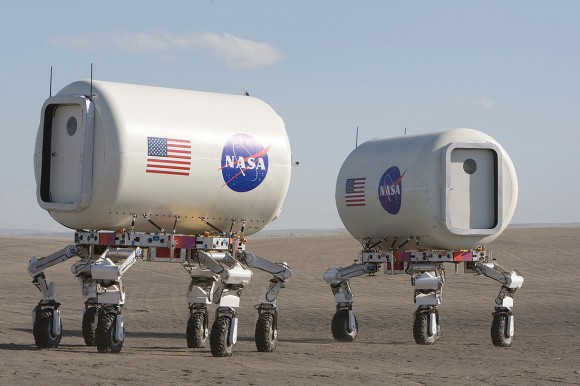
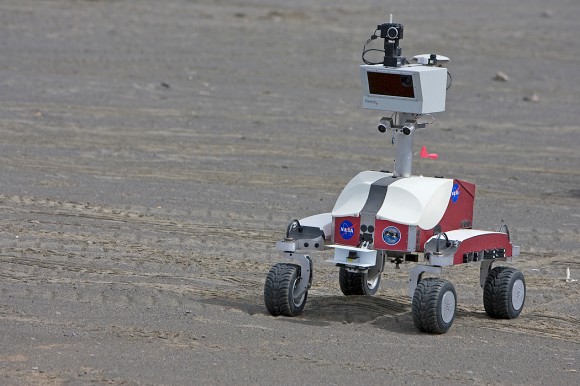
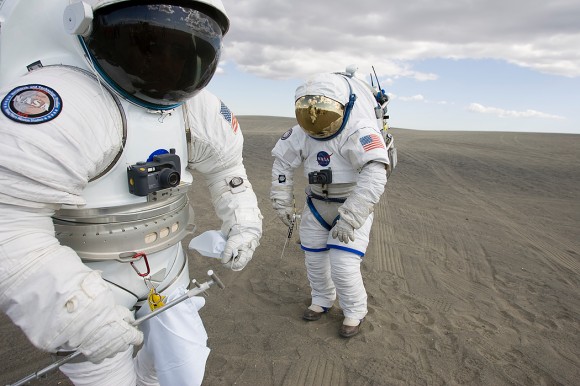
I want that Monster Without Skin. I want it now.
EXCELLENT! This is some cool engineering to be a part of, I’m sure.
I think I read something about some of this….
Nancy- Do you know, by chance, if Ares will have the capability of launching an ATHLETE in full? .. I suspect it, or something similar, will be the first step for the first modulated community.
Gosh, with all that money being thrown around, you’d think NASA would higher a design stylist for aesthetic purposes. That first picture looks like a monster without skin, and that second picture looks like a septic tank on wheels.
Monster without skin, cool
Septic tank on wheels design stinks, but looks effective. This isn’t Pimp my Moon Buggy.
There is nothing more awesome than a monster without skin. I want one.
Plus, those spacesuits are reinforcing bad posture
May I have the skin please?.. Extra crispy…
This isn’t Pimp my Moon Buggy, LMAO!!
What about just using a Segway?
Finally Nasa is preparing for a real moon journey. Not a hoax like Apollo.
“…unique features that allow each of its six wheels to move independently, giving the vehicle the ability to drive in any direction”
Is that really part of the job description? And besides it looks to me like it has twelve, not six, wheels.
Al — the Ares I can lift 50,000 lbs to LEO, and the Ares 5 can launch about 250,000 I believe, but I don’t know what the Lunar Transporter weighs. The biggest issue might be size, and having it fold up in some way to take up a little space as possible.
NoAstronomer —
Six sets of wheels, then.
Nancy,
Just a nit, it’s Moses Lake, not Lake Moses
That autonomous drilling rover sure does ride low to the ground. Looks like a race car! Am imagining a steering wheel and dashboard in front?
One of my favorites is the lunar bulldozer. Is there any reason that they don’t use treads/tracks like regular bulldozers? Weight perhaps? I was wondering if wheels might slip in the moons regolith when bulldozing. Just wondering.
Cool stuff. I wonder if its as fun to design these as it might seem. Probably a blast to test!
Tracks turn up a lot of dust compared to Wheels, additionally they weigh considerably more and if you have one track fail, your vehicle can only go in circles.
I wonder what modifications might need to be made to the machines since they will not be required to work in the same gravity as their testing ground, or if they are simply going to be sent up as is.
What is the primary purpose of such a vehicle? If it is to move people to/from various distances, how about something more like a motorized mountain bike? If it is for construction, seems like a backhoe sort of vehicle would have more options (add a blade, dig a trench, harvest green cheese…
“…how about something more like a motorized mountain bike?”
I suspect that NASA would rather not have users concentrating on balance, traction in turns, (all in low-g where Earth experience may not apply) and the risks of falling off.
We already know from the Apollo Lunar rover experience that it’s not hard to use a four-wheeled, low center-of-gravity vehicle on the Moon. (which itself borrowed much from terrestrial dune buggy/Jeep technology and experience)
The bulldozer attachment is interesting. Finally, a real piece of earthmoving equipment (or is that moon-moving?).
Personally I don’t see Nasa as being serious about having a permanent moon base until they’ve got plans for a hangar and machine shop worked out.
Otherwise how will they repair all this gear?
Without a place to do intricate work they’ll be forced to loft entirely new machines regularly, or bail on the whole project when the cost of doing so gets to be too much.
All for the want of a few small parts and elbow grease.
Side note:
Tracks are used to keep heavy equipment from sinking into the mud. On the moon, with light vehicles and low gravity, this is less of a problem. Wheels will be easier to keep clean and that will be very important in a high dust environment.
It is interesting to note how “pumped-up” people become at the prospect of colonizing and mining the moon. The expense to transport this fantasy equipment to the moon, establish a functional habitat and start even the simplest mining process staggers the imagination. At hundreds and hundreds of millions of dollars per round-trip makes absolutely no sense when considering any realistic or politically-spun pork-barrel return-on-investment. Gawd! What a monumental waste! Do we need change!
Change?
If you bothered to go outside at night and look up, you’d probably realize that theres alot more stuff out there than there is here.
The future of mankind (if we have one) will not be found down here in the relative calm between mass extinction events 23 and 24, quibbling about the cost of petrol.
These men are developing the most important skill since we first carved wooden boats, and your asking we burn that for firewood…
I’m with Maxwell… And it isn’t a question of “if” (as some seem to believe), it’s a question of “when”.
If we don’t end up destroying ourselves then nature will.. One way or another.
Apparently, we appear to be the first species on our planet that may have a little bit of a chance to -at least to an extent- be able to do something to ‘fight off’ our extinction. Philosophy aside, of course. Everything we do is natural (another story)… We better our odds of survival when we aren’t all in the same place. The sooner we spread out, the better ours chances.
What about the power source for these machines? The article didn’t specify. Is it solar? and then stored when dark?